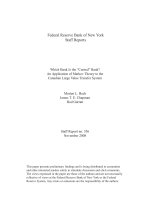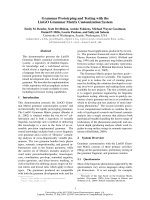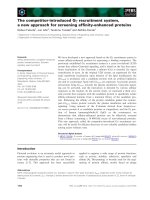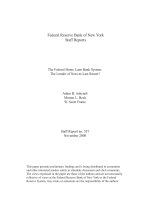The forex set forget profit system mark boardman
Bạn đang xem bản rút gọn của tài liệu. Xem và tải ngay bản đầy đủ của tài liệu tại đây (3.25 MB, 91 trang )
Mark Boardman’s
Forex “Set & Forget” Profit System
© 2013 by Mark Boardman All Rights Reserved. The word phrases “Forex Set &
Forget” TM and “Forex Break & Bounce” TM and “Forex Rebound” and “Forex Snap
back” TM are trademarks of Mark Boardman and may not be used in any way, shape, or
form, without the express written permission of Mark Boardman.
All intellectual property rights, including the Forex strategies and their mechanics of
operation remain the property of Mark Boardman and may not be copied or emulated.
2nd Edition, May 2013
To get access to a TOTALLY FREE Live Forex Trading Room visit his website:
www.forextradermark.com
Enter your name and e mail address in the form on the top right of the Home page and
then click on the link.
Introduction
Hi.
I hate “guarantees”, they sound so fake….however I am going to be a hypocrite and use
one now:
I guarantee that what you are about to learn will change the way you trade
Forex….forever…… and for the better!
So, why I am being a hypocrite in the first few sentences of my book?
Well, the answer is that what I am about to share with you is two radical concepts. I
learned them about three years ago, and they completely changed my attitude to Forex
Trading. Most importantly, they allowed me to transition from a consistently losing
trader into a consistently winning trader…..WITHOUT spending any money! Until
recently I ran a consultancy business. Now I pay all my bills by trading Forex part time.
I only trade for 5 or 6 hours a week, and it is in large part because of what I describe in
this book.
Consequently I can say with complete confidence that I guarantee that this book will
change the way you trade Forex…forever.
So please read on, and whilst the book is relatively compact, I do hope you will agree
that the information it contains is extremely valuable and will help you take a step in the
right direction towards a consistently profitable Forex trading journey. If you do feel
that way having read it, and you purchased the book from Amazon, I would be extremely
grateful if you would write a short, two line review on Amazon. It takes two minutes. I
give instructions of how to write a review at the end of the book.
You can e mail me at if you have any questions about this
book or my trading strategies and you can join a FREE Live Forex Trading Room
where I demonstrate what you will learn in the book, here:
www.forextradermark.com
Thanks
Mark
Risk Disclosure
What you are about to read in this book has changed my life. I am now financially
independent because of the system I employ when I trade Forex.
However, please note, and I repeat this many times in the book, that the system I use
requires a ‘’skill’’ that can only be learned through practice. The system is not robotic. It
is not a ‘’get rich quick’’ system. On the contrary, it is a Forex trading system that has
required a lot of discipline and hard work, and in return it delivers a good income for
me.
I feel very strongly that the Forex Industry is flooded with individuals and companies
that market products and services on the basis that you could make money easily and
quickly, which in my opinion is wrong, and I explain exactly why in the book.
My subtitle is:
It is very difficult to lose using this very reliable Forex trading system, and I maintain
that to be the case. The basis of the comment is proven in the book.
However, it is also very easy to lose if you do not follow your trading plan to the letter
and if you do not learn the ‘’skill’’ required to implement any systems that you use.
Trading Foreign Exchange on margin carries a high level of risk, and may not be
suitable for all investors. The high degree of leverage can work against you as well as
for you. Before deciding to invest in Foreign Exchange you should carefully consider
your investment objectives, level of experience, and risk appetite. The possibility exists
that you could sustain a loss of some or all of your initial investment and therefore you
should not invest money that you cannot afford to lose. You should be aware of all the
risks associated with Foreign Exchange trading and seek advice from an independent
financial adviser if you have any doubts.
Table of Contents
Chapter One
Radical Concept No.1 : Indicators ALONE will NEVER make you profitable long
term
Chapter Two
The greatest feeling in the world is TIME FREEDOM
Chapter Three
Radical Concept No.2: The Forex market is NOT trending 80-90% of the time
Chapter Four
So why trade Forex?
Chapter Five
Don’t believe the hype. Trading Forex is NOT complex
Chapter Six
My Indicators
Chapter Seven
My Three Forex Strategies
Chapter Eight
My Trading Track Record
Chapter Nine
The Forex “Set & Forget” Profit System
Conclusion
REAL trader testimonials
About Mark Boardman
Chapter One
Radical Concept No.1
Indicators ALONE will NEVER make you profitable long term
I trade Forex from home for about 5 or 6 hours per week. So I am a successful and selfsustained part time trader. However, here is what I am not:
I am NOT a professional trader.
I am NOT a trading guru.
I am NOT a millionaire who has gone from rags to riches trading Forex
I am NOT prophetic…I have no idea which way the market is going to go today. I
can take an educated guess, but I don’t have a Forex crystal ball.
One of the reasons for writing this short, but important book is that I am very frustrated,
and a little angry.
I feel this way because for just over 5 years I traded without making ANY
money….NONE!
During that 5 year period I spent a small fortune on trading platforms, data feeds, trading
software, trading signal services, trading books (including many of those you can find
on Amazon) and hundreds of hours on forums and working with so called Forex trading
‘’gurus’’. Yet I didn’t have a single year of profit…..and I am frustrated and angry
because in hindsight I now know that I was NEVER going to make any money taking the
route that I did.
I am a reasonably intelligent guy, yet I look back now in embarrassment at how easily I
was seduced by the many sales techniques used by companies and individuals trying to
make profit out of would be Forex traders.
Suffice to say for now that I was gullible, and I was so desperate to crack Forex trading
that I was easy prey for the marketers who sell software and ‘’buy and sell’’ signal
services.
What I now know is this one FACT:
There is NO magic bullet in the Forex Industry
Please take it from me, having traded for eight years. There is no software program that
will make you money. There are no indicators that alone will make you money. There
are no ‘’buy and sell’’ arrows that will make you money.
To underline what I am trying to say here, let me make an observation:
The big banks pay human Forex traders $millions in bonus payments every year for
hitting their Forex trading targets. If there was ANY software program, indicator, or
signal service that made profits consistently, wouldn’t the banks use that and save
hundreds of $millions in bonus payments?
Of course they would. The reason that the banks pay human Forex traders $millions in
bonuses is that they know that there is not a magic bullet, and the REASON that there is
not a magic bullet is that the Forex market is traded by humans, not machines or
programs. So humans, with human emotions are all staring at charts and making
emotional decisions, which is why no program will ever be able to replace a good
Forex trader.
Repeating Price Patterns
The good news is that human Forex traders tend to react to certain situations and then
make decisions in similar ways. So there is a kind of “herd mentality” if you like, that is
visible EVERY day in the Forex market.
This manifests itself in the form of what I call “repeating price patterns” that occur at
particular price levels, and it happens in all timeframes, from 1 minute charts to
monthly charts.
Now, whilst these “repeating price patterns” occur all the time, they cannot be
“forecasted”. This is why banks still pay human Forex traders to trade charts. The
patterns happen in real time and a trader needs to be at the charts to see them and take
advantage of them. A computer program cannot “see” the patterns. Only the human eye
can.
So, it is absolutely possible to be a consistently profitable Forex trader, and you can
make it by trading part time, a few hours a week. However it takes some effort and in
particular, learning of the repeating price patterns.
So my first radical concept is this:
Indicators alone will NEVER make you profitable long term. Only the human eye
can detect and take advantage of the “repeating price patterns” that occur in the
Forex market.
Hence, it is a complete waste of money buying ANY software or indicators in the hope
that trading the “signals” alone will make money in the long term, because they will not
be able to show you where and when these repeating price patterns occur.
Let me also say this:
Almost ALL indicators lag the market. I have only come across five indicators, out of
hundreds, that have given me a “reliable” idea of where the market is “likely” to go
next.
In addition repeating price patterns can give you an educated guess as to where the
market is “likely” to go next. So I use a combination of the five lagging but very useful
indicators, the repeating price patterns at particular price points, plus the ‘’Set &
Forget’’ profit system to make my living in the Forex market.
In my 5 years of unprofitable trading, apart from the expensive software I purchased, I
also tried the following popular FREE indicators….all without success:
Stochastics
Multiple moving averages
MACD
ADX
CCI
Fibonacci
Elliot waves
Gann
…and many more. Some of the so called ‘’miracle’’ money making systems I bought
were:
Forex Profit Mountain
The 10 minute Forex wealth builder
Forex Detector
Pip scooper
….and many more.
Though I use five indicators when I trade I do not use them as signals to enter or exit the
market. I use them for one simple reason…they give me an “idea” of where the market
“might” go next. So they help my “eye” to spot the price patterns.
However, they are still lagging indicators and I would NEVER use them in isolation to
place a trade. I use my “chart reading” skills to place my trades, and my five lagging
indicators are just there to help.
There is no quick way to make money in Forex. There are no automated tools that will
do it for you. In my opinion, as you will hear me say many times in this book, the ONLY
way to make profit consistently from Forex is by being able to “read the charts’’,
because indicators ALONE will never, in my opinion, make you profitable in the long
term.
Learn for FREE
If you would like a completely FREE lesson in ‘’chart reading’’ then join my FREE Live
Forex Trading Rooms. To join go to my website:
www.forextradermark.com
Enter your name and e mail in the form at the top right of the page and I will send you an
e mail with e registration link for the next FREE Forex Trading Room.
Chapter Two
The greatest feeling in the world is TIME FREEDOM
I often use the analogy of learning to play a musical instrument to describe what I think
is required to make money in this industry. I have played guitar for over thirty years.
Learning to play the guitar to a reasonable standard is not complex, but it takes time, and
patience. If you have enough time and enough patience, you can become a very
competent guitarist. Thirty years later I still cannot read music, but I didn’t need to be
able to read music to be a good guitarist. I just needed to learn all the chords and then
do three things:
1. Practice
2. Practice
3. Practice
If you do that, you are guaranteed to be able to play the guitar. Of course, if you can read
music too you could be an even better guitarist, but you don’t need to be able to read
music to get to a competent level.
One of the reasons I took up Forex trading was so that I could have more free time to do
the things I REALLY want to as well as not having the responsibility of employees and
the stresses of running a company. One of the things I REALLY like to do is sit down
every day and write a quick song. Trading Forex part time makes me enough money to
pay all my bills, so I now have lots of spare time to write songs. I still can’t read music,
but I can put a tune together, so I have reached a level of competence with my guitar that
I am happy with.
I have done the same thing with my Forex trading.
I could study fundamental analysis and relational analysis. I could analyse the
relationship between the economies of the world. I could look at the correlation
between oil, gold, the dollar index, and so on, but I choose not to. I have reached a level
of competence in Forex trading that I am happy with. I don’t want to be a millionaire. I
just want to make enough money from my trading to give me the most precious
commodity of all which is
TIME FREEDOM.
Apart from the 5 or 6 hours per week when I am at my computer trading, and the other 5
hours when I do my live trading rooms, I have complete freedom to do what I want, and
it is the most liberating feeling in the world.
I have achieved this feeling by embracing the two radical concepts in this book. If you
embrace them I believe that you too can achieve your personal goals by freeing up your
time.
I have struck a balance with my trading. I suppose I could make a lot more money by
combining my understanding of my two concepts with the study of fundamental and
relational analysis, but I would rather not trade full time. I enjoy looking at the charts for
a couple of hours at most. After that I start to get bored. So trading part time suits me
fine. I am a technical trader, that’s it. I just study charts and use my ‘’Set & Forget’’
Profit System, and live a completely stress free life.
So, having traded unsuccessfully for 5 years, and then successfully for 3 years, all
because of the two concepts in this book, then I hope my experience helps you to get
what you want from the Forex market.
The bottom line is that I now trade using a “skill’ that I have learned called “chart
reading”, and I learned it through practicing. I now have a good understanding of the
repeating price patterns that occur every day and in every time frame. I have ditched the
software and the expensive trading platforms and data feeds. I now trade using a free
platform, no software, and a few indicators, and my strategies work.
I hope this gives you some encouragement. If I can do it, anybody can.
I am going to come back to my first concept later in the book, but for now I want to
move on to the second radical concept.
Chapter Three
Radical Concept No. 2
The Forex market is NOT trending 80-90% of the time
All over the internet you will find hundreds of websites about Forex trading. 99% of
them are trying to sell you expensive software, signal services and all kinds of other
products.
One of the clever sales techniques they use to lure you in to buying their product is to
suggest that it will help you to trade…with the trend.
Most traders, and I include my previous self here, get obsessed with locating and then
“riding” the trend. More books have been written about trend trading than any other
aspect of trading. If you look at ALL the software on the market it usually has green and
red dots or arrows, which gives any chart the impression of being in either an uptrend
or a downtrend 80% of the time.
This is very seductive to a trader. When I look back at all the software I bought, one of
the most alluring things about the software was the visual “picture” it gave me of the
market. Looking at what appears to be a clearly trending market gave me confidence. I
figured that if I placed a long trade when the arrows or dots turned green and then
closed the trade when they turned red (and vice versa for a short trade) I would be
profitable.
So I purchased a lot of products because I believed that they would get me in and out of
the trend at the right time.
However, I never made any money consistently using the software I bought. I now know
that the reason for that is because of my second radical concept....which is this…
The Forex market is NOT trending 80-90% of the time.
If you look at any Forex chart you will see what ‘’appear’’ to be trends. You will see the
price go steadily up and steadily down, so the price patterns look like trends. However,
when you look at them in more detail you will start to see that the vast majority of the
time the charts are ‘’channelling’’ and moving from side to side, followed by
‘’breakouts’’….then more side to side movement….and so on.
To explain this further let me pose a question….if a market is trending, when did the
trend start….and when does the trend that started eventually end? Some say it is the
breaking of a swing high/low. Others say it is when one moving average crosses
another.
The big question is, in real time, when you are looking at the price NOW, and not in the
past, is price trending or not? The answer is that you don’t know for sure. So you can
only rely on what looks like a trend from the historical price, and that’s when price can
appear to be trending. Let me show you an example. Here is a daily chart of the EUR
USD, which I am looking at now as I write this book:
The purple line appears to show a price uptrend above it doesn’t it?
Now let’s look at the same chart with another so called ‘’trend line’’.
This looks like a downtrend now doesn’t it?
Now let’s look at the chart with both lines on.
The ‘’uptrend’’ still looks like an uptrend but the ‘’downtrend’’ isn’t as convincing now
because what was the start of the downtrend is actually still part of the initial uptrend.
Let’s now have a look at the chart from a different perspective:
This is the same chart but a little bit further back in time and you can see that the market
is “channelling”…..or “moving sideways”.
Now look at the chart with the channelling lines and both ‘’trend lines’’ on it:
Now you can see that most of the uptrend (red line) is eaten up by the channelling lines
(purple lines), meaning that half of the uptrend is not valid.
You could do this with a thousand charts and you will find that real ‘’steady trends’’
only occur about 20% of the time, at best, and I think the figure is nearer 10%. So any
indicator or software that gives the ‘’suggestion’’ that the market is trending more often
than 10 to 20% of the time is simply seducing the trader into thinking that the market is
trending when in fact it isn’t. Most of the time the market is channelling and moving in
what is often called a ‘’sideways movement’’, which I call channelling.
Most price patterns that look like “trends” are in fact more like this:
….a channel followed by a breakout, then another channel, then another breakout…and
so on.
Here is an example with the Cable (GBP USD) as I write this book:
So most ‘’trends’’ are really just multiple breakouts. REAL ‘’steady’’ trends do not
happen frequently, and being able to spot the difference between a real ‘’steady’’ trend
and a channel/breakout price movement is critical if you want to ‘’trade the trends’’.
The ‘’trend is your friend’’ sales technique sells a lot of software and a lot of indicators,
so I can see why companies and individuals use it to convince us that trading with the
trend is the way to make money. They then show you charts with ‘’trends’’ all over the
place….and guess what happens next? Well in my case, I bought the software on many
occasions….that’s what happened next for me. I fell for the sales technique.
There was in fact one piece of software that I invested in that was better than all the
others, and it did have green and red dots to suggest whether the market is in a
downtrend or an uptrend. I found the software helped me with some trades and it gave
me more confidence, but I must stress that it did not give me anywhere near as much
success as I have had since I have traded without any software.
So I guess I am saying that trading software may work for some traders, but not for me,
at least not consistently, and the traders I know that do make money CONSISTENTLY
all trade using price patterns, not software or signal services.
Before I move on let me repeat my two radical concepts.
Radical Concept No. 1:
Only the trained human eye can spot the recurring price patterns that occur every day in
the Forex market. Computers and their programs cannot!
Radical Concept No. 2:
The markets are NOT trending most of the time so trying to take ‘’trend only’’ trades
makes it difficult to make profits consistently as it is difficult to spot the real ‘’steady’’
trends. To do so you would need to be at the charts 8 hours a day. That’s ok for
professional traders, but not for a part time trader like me.
Chapter Four
So why trade Forex?
If you are new to Forex you may be reading this book and thinking…..if the Forex
market does not trend a lot…..why trade Forex…why not trade stocks or commodities
or indices instead?
Well, I am not saying that you shouldn’t trade other instruments, but I am very “pro”
Forex for the following reasons:
1. Forex is the most liquid market in the world.
2. Forex rarely “gaps”
3. Forex can be traded 24/7, five days per week.
4. There are far fewer decisions to make trading Forex
5. Forex cannot move too far, too fast
6. Forex exhibits “repeating price patterns” more regularly than any other market
Let me take each of these points and explain why they are important to me.
1. Forex is the most liquid market in the world
Do you know what the dollar value is of every stock traded on the New York stock
exchange per day?
The answer is approximately $24 billion. So, if you add all the trades placed for the
world’s biggest companies together, including the Bank Of America, Dell, Microsoft,
Google…and ALL the other HUGE global companies…you get $24 billion per day.
Retail traders (that’s you and me…not the big banks….more on them later) trade about $
1.5 trillion on the Forex spot market each day.
So we Forex traders trade 65 times more than the entire world’s stock investors do in
the NYSE each day. In addition, another $3.5 trillion is traded in the Forex spot market
by banks and other intuitions. The Forex market is the biggest market in the world by far.
Why is this important? From my point of view the answer is that the more liquid an
instrument is the tighter the bid/ask price can be and the easier it is to get into and out of
a trade. In basic terms this means I am giving less back to the ‘’middle man’’. If you are
new to Forex, don’t worry if you don’t understand this concept. It really doesn’t matter,
but it is worth noting that Forex is, in my opinion, the ‘’easiest’’ market to trade.
2. The Forex market rarely “gaps”
A spin off benefit of extremely high liquidity is that Forex pairs rarely “gap”.
Here is a picture of a “gap”:
This is a gap that appeared on the AUD USD. As you can see the market unpredictably
falls, without any apparent trading volume.
Gaps are a nightmare to trade, at least for me, and they occur regularly in the stock
market. I traded stocks for a couple of years. I even studied a “gap trading” course, but I
couldn’t get the knack of it and I found trading gaps stressful.
Gaps rarely occur in Forex because there is so much liquidity, and the Forex market
does not close overnight like the stock market does. The gaps that do appear in the
Forex market are almost always on a Sunday night, when I don’t trade. The only other
time it happens is when there is huge “news” that is unexpected, which is also rare.
There is lots of “news” that affect the Forex markets, but rarely is it so unexpected that
it is not “factored in” to the price movements.
The bottom line is that I don’t like gaps. As you will read in Chapter Nine (The Forex
“Set & Forget” Profit System”) I play a mathematical game with the market, which
relies on “probabilities”. These probabilities are more likely with a “smooth” market.
So I want to trade “gap free” and Forex allows me to do that.
3. Forex can be traded 24/7, five days per week.
The Forex market also differs from the stock market in another way. From Monday to
Friday it doesn’t close, as I noted above. It can be traded 24/7 for 5 days a week. It is
also very liquid for about 18 of each 24 hour period. So I can go to my lap top at 6 am,
or 6 pm, or any time in between, and see the same chart patterns appearing. Not only
does the stock market close, but it also quietens down during ‘’lunch’’ hours, losing
liquidity. I don’t like that. I like my time freedom, and I want to be able to trade Forex at
the hours I choose, not the hours that the market wants me to. So with Forex I can relax
about when to trade, knowing that there is enough trading happening whatever time I
trade.
4. There are far fewer decisions to make trading Forex
As you will read in the next chapter (Don’t believe the hype. Trading Forex is NOT
complex) my style of trading is relaxed, and I use a very simple system. I spent years,
and lots of money looking at the complex ways of trading, and I didn’t make money. So
one of the attributes of my current trading style is that I try to minimize the number of
decisions I need to make when I enter and exit a trade.
I found trading stocks was far more complex than trading Forex. The main reason I
found stock trading complex and more confusing is that the number of choices of stocks
to choose from is so huge. Even if you focus on the more liquid stocks, there are still
hundreds to choose from. So then it’s a case of choosing an industry perhaps? Ok, so
which industry…and then which companies in that industry? For me, the whole aspect
of ‘’choosing’’ which stocks to trade involves too many decisions, and I found that too
stressful.
With Forex I only trade 8 currencies, and the way I trade, which you will read more
about later, is such that I can easily “narrow down” on which currency pairs to trade in
a matter of minutes. This means that I am making very few “decisions”….in fact, using
my strategies the way I do, most of the decisions are made for me by the trading rules in
my strategies.
So for me trading Forex makes life a whole lot easier, and minimises my decision
making processes.
5. Forex cannot move too far, too fast
The Forex market is unique in one respect, which is that because it involves currencies
that belong to nations (and a whole economic region in the case of the Euro) then the
price of each currency in relation to any other can never be zero….it is not possible for
a currency to reach zero value. Recently the Bank of Japan (in cahoots with the Japanese
government) has done a very good job of devaluing the Yen, because by doing so their
economy benefits….but they will not be able to devalue it forever…there will come a
point at which the other currencies will ‘’peg it back’’. Check any Forex chart and you
will see that over the last 20 years no currency has been able to keep on rising in value,
or keep falling in value.
This is because the countries and regions of the world are in a constant currency war.
They are all battling for their currency to be at a particular value.
It is not necessary to understand the fundamental reasons for this. I barely understand it,
but what is important to know is what this means for a currency trader….because it is
very good news.
Currencies cannot rise or fall too much over time because the people that move the
currencies (the banks) are all battling it out and the “battle” manifests itself in all time
frames. When you look at any currency chart you will see that all currency pairs rise,
and then fall, like all financial instruments do.
However I noticed that they only ever rise, or fall, by a certain mathematical
‘’range’’ before they then head back in the other direction.
The Forex “Snap Back”
Due to this mathematical phenomenon Forex currencies literally get ‘’overstretched’’,
like they are on an elastic band…and they eventually get so overstretched that they have
to ‘’snap back’’ into position. I talk more about this later but it is a magnificent
phenomenon and I use it to make profitable trades every day. It forms the fundamental
basis of my Forex ‘’Snap Back’’ Strategy.
I have recently created my own indicator to tell me when this ‘’overstretching’’ of a
currency pair outside its usual ‘’range’’ happens, so that I am alerted when to watch out
for a trade. It is called the Apollo Currency Strength Indicator and you can read more
about it in Chapter Six (My Indicators.)
Suffice to say, and it really doesn’t matter why it happens….. ….the Forex currency
pairs cannot get ‘’overstretched’’ too much in ANY time frame. They cannot get
‘’overstretched’’ in a 1 minute chart, or a monthly chart, or any timeframe in between.
My Apollo Currency Strength Indicator proves this to be the case.
This is where currencies differ from stocks and commodities, which can go on huge bull
and bear trends. Bull and bear trends are fine if you know how to time them, and know
when they are likely to end…but that’s something I never mastered. It’s a case of
spotting real ‘’steady’’ trends again which, for me, takes too much time.
It really is great news that currencies behave in this way because it leads to the next
reason I trade Forex.
6. Forex exhibits “repeating price patterns” more regularly than any other market
Although the Forex market does not trend that much I have observed that it does do one
thing more often than any other market:
It exhibits “repeating price patterns” in every time frame, and does so with remarkable
regularity and reliability.
One of the “repeating price patterns” are “tails”, which you will read more about soon.
Tails occur very frequently when the market gets “overstretched” and this presents
fantastic trading opportunities every day.
As I said earlier I play a ‘’mathematical game’’ with the Forex market. I simply look to
place the mathematical odds in my favor, and I do that with three ingredients. You will
read more about the three ingredients in the main chapter The Forex ‘’Set & Forget’’
Profit System.
One of those ingredients is being able to make more profitable trades than losing
trades…which is of course what almost all traders aim to do. In order for me to do that I
simply look for “repeating price patterns” and one of them is “tails” at particular price
points. When “tails” occur, and the market is overstretched, and they occur at a
predetermined point of support/resistance, then the number of times I profit ALWAYS
outnumbers the number of times I lose. So the first ingredient of my success formula is
achieved because of the “repeating price patterns”.
No other market produces as many, or as reliable, price patterns, in my experience, and
it is the BIGGEST reason I trade Forex.
Summary
I love trading Forex, and I won’t trade any other market again. I have tried trading many
other markets, especially stocks, and stock options, but Forex wins hands down for the
six reasons I describe above.
The fact that it doesn’t trend very often is not a bad thing. In fact, it’s a good thing,









